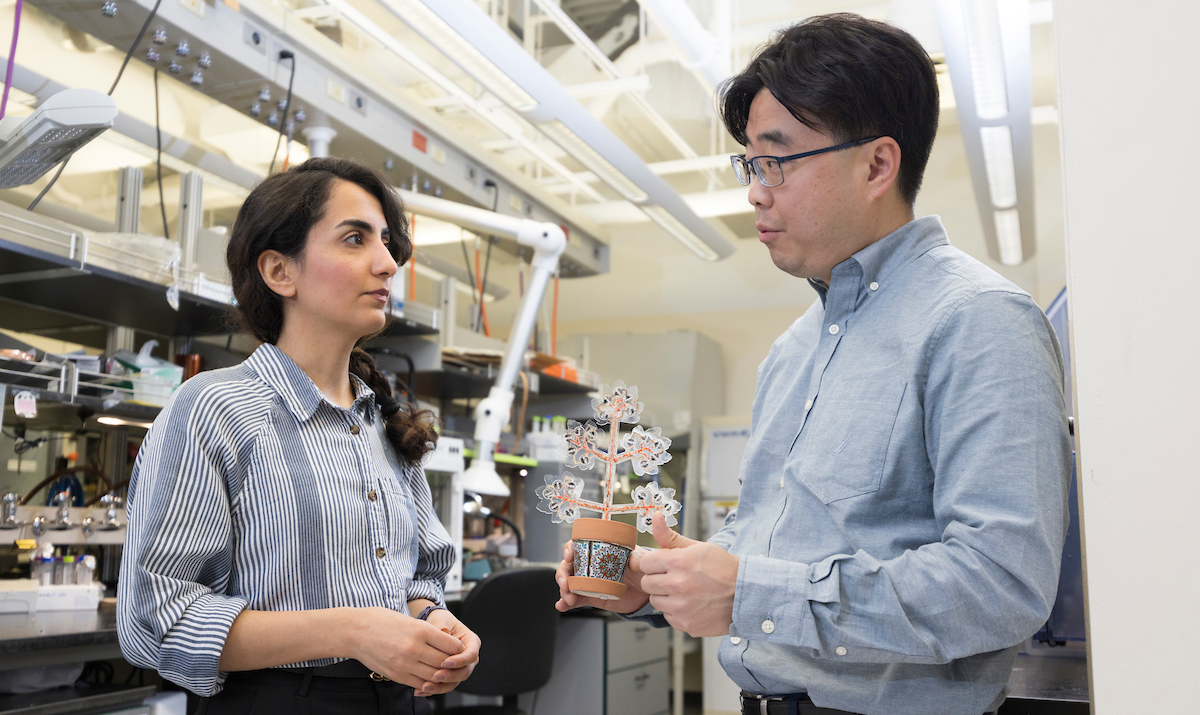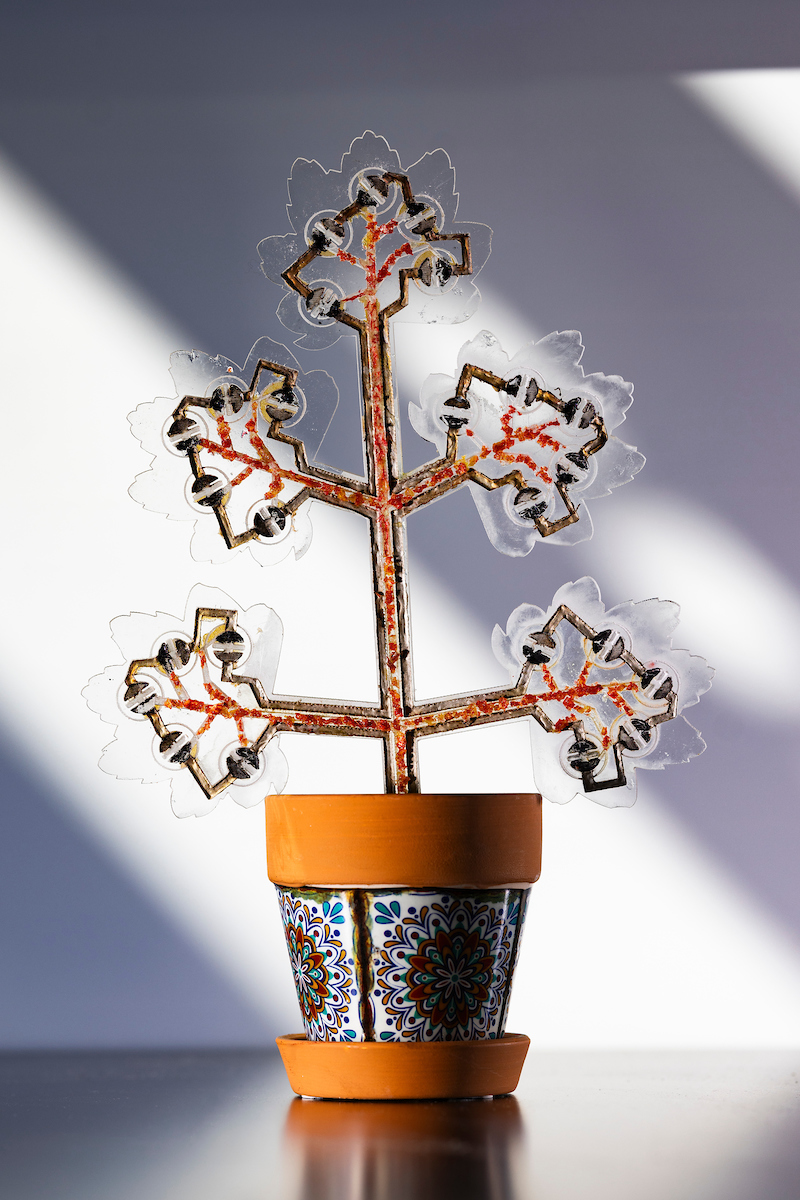Welcome to DU!
The truly grassroots left-of-center political community where regular people, not algorithms, drive the discussions and set the standards.
Join the community:
Create a free account
Support DU (and get rid of ads!):
Become a Star Member
Latest Breaking News
Editorials & Other Articles
General Discussion
The DU Lounge
All Forums
Issue Forums
Culture Forums
Alliance Forums
Region Forums
Support Forums
Help & Search
Environment & Energy
Related: About this forumArtificial plant guzzles carbon and produces electricity

Made of tiny bacteria, the new fake plant soaks up more carbon than its natural cousins, and produces electricity to boot
By Anthropocene Team
October 10, 2024
In an effort to one-up nature, engineers have created an artificial plant that captures carbon dioxide ten times more efficiently than its natural counterparts. And it generates enough electricity to power a lamp.
The fake plant is built with bacteria-based solar cells, and looks odd. But it offers a fun, novel concept to tackle two important issues: carbon dioxide removal and clean electricity generation.
Carbon dioxide is the main planet-warming greenhouse gas. It is also an important indoor air pollutant that threatens human health, write Maryam Rezaie and Seokheun Choi, electrical and computer engineers at the State University of New York at Binghamton, in their Advanced Sustainable Systems paper.
The European standard for a safe carbon dioxide threshold indoors is 800 parts per million (ppm). But studies report that carbon dioxide levels in indoor environments often exceed 2,500 ppm.
More:
https://www.anthropocenemagazine.org/2024/10/artificial-plant-produces-electricity-while-guzzling-carbon-dioxide/
2 replies
 = new reply since forum marked as read
Highlight:
NoneDon't highlight anything
5 newestHighlight 5 most recent replies
= new reply since forum marked as read
Highlight:
NoneDon't highlight anything
5 newestHighlight 5 most recent replies
Artificial plant guzzles carbon and produces electricity (Original Post)
Judi Lynn
Oct 2024
OP
Binghamton researchers develop artificial plants that purify indoor air, generate electricity
OKIsItJustMe
Oct 2024
#2
AKwannabe
(6,521 posts)1. Cool Judi Lynn. Cool!
Hoping it is “good” bacteria!
🦠
OKIsItJustMe
(21,031 posts)2. Binghamton researchers develop artificial plants that purify indoor air, generate electricity
Last edited Thu Oct 24, 2024, 03:29 AM - Edit history (1)
https://www.binghamton.edu/news/story/5165/binghamton-researchers-develop-artificial-plants-that-purify-indoor-air-generate-electricityBinghamton researchers develop artificial plants that purify indoor air, generate electricity
Professor Seokheun “Sean” Choi and PhD student Maryam Rezaie are repurposing their ideas about bacteria-powered biobatteries into a new idea

By Chris Kocher OCTOBER 04, 2024
On average, Americans spend about 90% of their time indoors, and the air we breathe at work, school or home affects our overall health and well-being.
Most air purification systems, however, are expensive, cumbersome and require frequent cleaning or filter replacement to function at optimum levels.
Binghamton University Professor Seokheun “Sean” Choi and PhD student Maryam Rezaie are repurposing their research about bacteria-powered biobatteries — ingestible and otherwise — into a new idea for artificial plants that can feed off carbon dioxide, give off oxygen and even generate a little power. The artificial plants use indoor light to drive photosynthesis, achieving a 90% reduction in carbon dioxide levels — far surpassing the 10% reduction seen with natural plants.
They outline their results, which is partially supported by the Office of Naval Research, in a paper recently published by the journal Advanced Sustainable Systems.

The artificial plants developed at Binghamton University use indoor light to drive photosynthesis, achieving a 90% reduction in carbon dioxide levels — far surpassing the 10% reduction seen with natural plants. Image Credit: Jonathan Cohen.
…
Professor Seokheun “Sean” Choi and PhD student Maryam Rezaie are repurposing their ideas about bacteria-powered biobatteries into a new idea

By Chris Kocher OCTOBER 04, 2024
On average, Americans spend about 90% of their time indoors, and the air we breathe at work, school or home affects our overall health and well-being.
Most air purification systems, however, are expensive, cumbersome and require frequent cleaning or filter replacement to function at optimum levels.
Binghamton University Professor Seokheun “Sean” Choi and PhD student Maryam Rezaie are repurposing their research about bacteria-powered biobatteries — ingestible and otherwise — into a new idea for artificial plants that can feed off carbon dioxide, give off oxygen and even generate a little power. The artificial plants use indoor light to drive photosynthesis, achieving a 90% reduction in carbon dioxide levels — far surpassing the 10% reduction seen with natural plants.
They outline their results, which is partially supported by the Office of Naval Research, in a paper recently published by the journal Advanced Sustainable Systems.

The artificial plants developed at Binghamton University use indoor light to drive photosynthesis, achieving a 90% reduction in carbon dioxide levels — far surpassing the 10% reduction seen with natural plants. Image Credit: Jonathan Cohen.
…
https://doi.org/10.1002/adsu.202400401
…
3 Future Direction
We anticipate that our artificial plant can be effortlessly installed in any indoor environment in a cost-effective, maintenance-free, and eco-friendly manner. Since it is power-free and self-sustaining, no external energy sources or accessory components are required. However, additional studies are necessary to further refine its practical applications. Here, the long-term operation necessary for ideal and permanent improvements in indoor air quality was not achieved. The use of a single bacterial species may limit long-term bacterial viability, suggesting that engineered co-culture communities might be more advantageous for sustained operation. Additionally, exploring the genetic engineering of bacteria could enhance performance. Moreover, minimizing maintenance, which can be achieved through optimized water and nutrient delivery systems, is crucial for practical application. Regarding power performance, generating higher power output is essential for more practical indoor applications, such as charging a cellphone. It is anticipated that a minimum output of more than 1 mW is necessary. To accomplish this, further improvements in materials and device structures are required. Increasing the compactness and number of biosolar cells could significantly enhance power output. Additionally, integrating energy storage solutions, such as lithium-ion batteries and supercapacitors, should be considered to make the system more effective and versatile for real-world applications. These future directions will pave the way for cyanobacterial artificial plants to become a viable technology for indoor environmental management and sustainable energy.
…
3 Future Direction
We anticipate that our artificial plant can be effortlessly installed in any indoor environment in a cost-effective, maintenance-free, and eco-friendly manner. Since it is power-free and self-sustaining, no external energy sources or accessory components are required. However, additional studies are necessary to further refine its practical applications. Here, the long-term operation necessary for ideal and permanent improvements in indoor air quality was not achieved. The use of a single bacterial species may limit long-term bacterial viability, suggesting that engineered co-culture communities might be more advantageous for sustained operation. Additionally, exploring the genetic engineering of bacteria could enhance performance. Moreover, minimizing maintenance, which can be achieved through optimized water and nutrient delivery systems, is crucial for practical application. Regarding power performance, generating higher power output is essential for more practical indoor applications, such as charging a cellphone. It is anticipated that a minimum output of more than 1 mW is necessary. To accomplish this, further improvements in materials and device structures are required. Increasing the compactness and number of biosolar cells could significantly enhance power output. Additionally, integrating energy storage solutions, such as lithium-ion batteries and supercapacitors, should be considered to make the system more effective and versatile for real-world applications. These future directions will pave the way for cyanobacterial artificial plants to become a viable technology for indoor environmental management and sustainable energy.
…